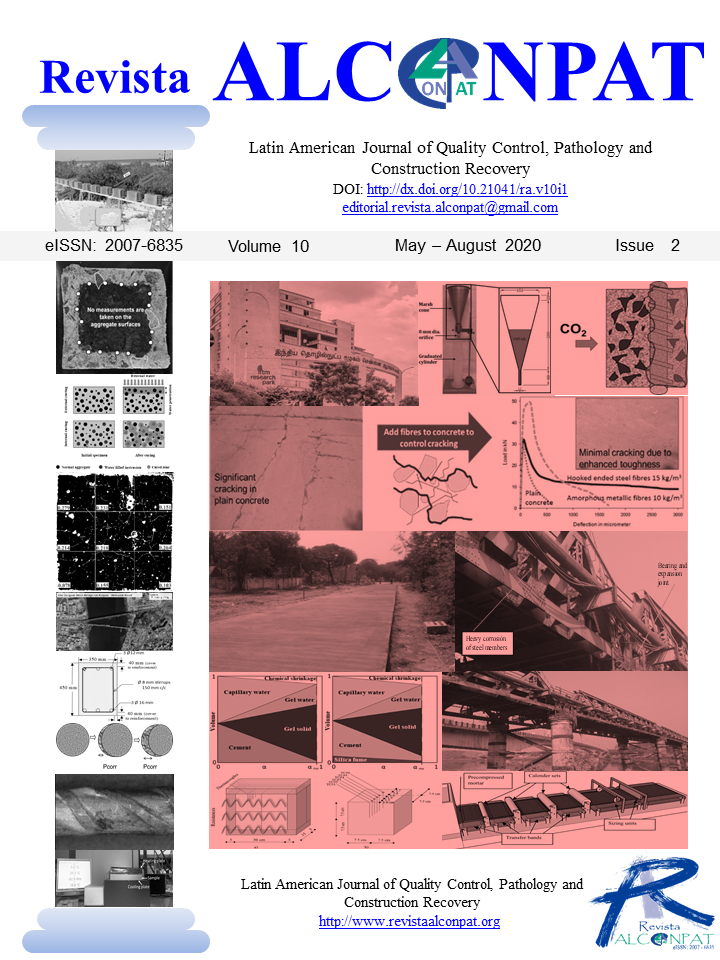Synergetic effect of a super-absorbent polymer and a calcium nitrite corrosion inhibitor in high performance concrete durability
DOI:
https://doi.org/10.21041/ra.v10i2.450Keywords:
high performance concrete, super-absorbent polymer, calcium nitrite corrosion inhibitor, silica fume, durabilityAbstract
In this research, the synergetic effect of a super-absorbent polymer in combination with a calcium nitrite corrosion inhibitor were evaluated as a combined technology to improve concrete durability in High Performance Concrete. For this purpose, Portland cement mortars with a water/cement ratio of 0.4 and a substitution of 9.5% of cement by silica fume were produced. The effect of this technologies was evaluated by measuring the following parameters: autogenous and drying shrinkage, surface electrical resistivity and the non-steady-state chloride migration coefficient. The results indicate that the synergistic effect of SAP + CNI improves autogenous shrinkage and surface electrical resistivity.
Downloads
References
American Association of State Highway and Transportation Officials. (2011). AASHTO TP 95: Standard Method of Test for Surface Resistivity Indication of Concrete’s Ability to Resist Chloride Ion Penetration. Washington, DC.
Ampadu, K. O. Torii, K., Kawamura, M. (1999), Beneficial effect of fly ash on chloride diffusivity of hardened cement paste, Cement and Concrete Research, 29 (4), 585–590. https://doi.org/10.1016/S0008-8846(99)00047-2
Craeye, B., Geirnaert, M., DeSchuttera, G. (2011), Super absorbing polymers as an internal curing agent for mitigation of early-age cracking of high-performance concrete bridge decks. Construction and Building Materials. 25, 1-13. https://doi.org/10.1016/j.conbuildmat.2010.06.063.
Cusson, D., Lounis, Z., Daigle, L. (2010), Benefits of internal curing on service life and life-cycle cost of high-performance concrete bridge decks – A case study. Construction and Building Materials, 32, 339-350 https://doi.org/10.1016/j.cemconcomp.2010.02.007.
De la Varga, Castro, J., Bentz, D., Weiss, J. (2012), Application of internal curing for mixtures containing high volumes of fly ash. Cement & Concrete Composites, 34 1001–1008, https://doi.org/10.1016/j.cemconcomp.2012.06.008.
Gaidis, J. M. (2004). Chemistry of corrosion inhibitors. Cement and Concrete Composites, Vol. 26, pp. 181–189. https://doi.org/10.1016/S0958-9465(03)00037-4.
Hansson, C. M., Mammoliti, L. Hope, B. B. (1998). Corrosion Inhibitors in concrete Part I - Principles. Cement and Concrete Research, Vol. 28, No. 12, pp. 1775–1781. https://doi.org/10.1016/S0008-8846(98)00142-2.
Jensen, O., Hansen, P. F. (2001), Water-entrained cement-based materials, PCT Patent Application WO01/02317A1.
Jensen, O., Hansen, P. F. (2001), Water-entrained cement-based materials I. Principles and theoretical background, Cement and Concrete Research, Volume 31, Issue 4, pages 647-654. https://doi.org/10.1016/S0008-8846(01)00463-X.
Jensen, O. Hansen, P. F. (2002), Water-entrained cement-based materials II. Experimental observations, Cement and Concrete Research, Volume 32, Issue 6, June pages 973-978. . https://doi.org/10.1016/S0008-8846(02)00737-8.
Lothenbach, B., Scrivener, K., Hooton, R. D. (2011), Supplementary cementitious materials, Cement and Concrete Research Num. 41 1244-1256. https://doi.org/10.1016/j.cemconres.2010.12.001.
Mechtcherine, V., Reinhardt, H. (2012), Application of Superabsorbent Polymers (SAP) in Concrete Construction State of the Art Report Prepared by Technical Committee 225-SAP, https://doi.org/10.1007/978-94-007-2733-5.
Nordest (1999), NT Build 492: Concrete, mortar and cement-based repair materials: Chloride migration coefficient from non-steady-state migration experiments.
Nilsson, L., Ngo, M., & Gjørv, O. (1998). High-performance repair materials for concrete structures in the port of Gothenburg. En O. Gjørv, K. Sakai, & N. Banthia, Concrete under severe conditions: environment and loading, volumen 2, pp 1193-1198. Tromsø, Norway: E & FN Spon. https://doi.org/10.1201/b16469.
Pendergrass, B., Darwin, D. (2014), Low-cracking High-Performance Concrete (LC-HPC) bridge decks: Shrinkage-Reducing Admixtures, Internal Curing, and cracking performance. Structural Engineering and Engineering Materials SM Report no. 107. The University of Kansas Center for Research, INC, Lawrence Kansas. https://kuscholarworks.ku.edu/handle/1808/19821.
Powers, T. C., Brownyard, T. L. (1948) Studies of the physical properties of hardened Portland Cement pastes, Journal of the American Concrete Institute, USA.
Quraishi, M. A., Nayak, D. K., Singh, B. N., Kumar, V., Pandey, K. K. (2016), Experimental Studies on Effects of Sodium Citrate, Calcium Nitrite and Hexamine as Corrosion Inhibitor in Concrete; Journal of Steel Structures & Construction, 5 pp; doi: 10.4172/2472-0437.1000117.
Sellevold, E. J. Radjy F. F. (1982), Condensed silica fume in concrete, Report BML 82.610. Division of Building Materials. The Norwegian Institute of Technology & The University of Trondheim, Norway.
Shi, C. (2004), Effect of mixing proportions of concrete on its electrical conductivity and the rapid permeability test (ASTM C1202 or ASSHTO T277) results, Cement and Concrete Research, 34 (3), 537–545. https://doi.org/10.1016/j.cemconres.2003.09.007.
Snoeck, D. Jensen O. M., De Belie N. (2015), The influence of superabsorbent polymers on the autogenous shrinkage properties of cement pastes with supplementary cementitious materials. Cement and concrete research 74, 59-67. https://doi.org/10.1016/j.cemconres.2015.03.020.
Tange Hasholt, M., Mejlhede Jensen, O. (2015), Chloride migration in concrete with superabsorbent polymers, Cement and Concrete Composites, 55, 290-297. https://doi.org/10.1016/j.cemconcomp.2014.09.023.
Zhutovsky S. and Kovler K. Effect of internal curing on durability-related properties of high performance concrete, Cement and concrete research (2012), vol. 42., 1, pages 20-26, https://doi.org/10.1016/j.cemconres.2011.07.012.
Downloads
Published
How to Cite
Issue
Section
License
_______________________________
License in effect from September 2020
You are free to:
- Share — copy and redistribute the material in any medium or format for any purpose, even commercially.
- Adapt — remix, transform, and build upon the material for any purpose, even commercially.
- The licensor cannot revoke these freedoms as long as you follow the license terms.
Under the following terms:
- Attribution — You must give appropriate credit , provide a link to the license, and indicate if changes were made . You may do so in any reasonable manner, but not in any way that suggests the licensor endorses you or your use.
- No additional restrictions — You may not apply legal terms or technological measures that legally restrict others from doing anything the license permits.
Notices:
You do not have to comply with the license for elements of the material in the public domain or where your use is permitted by an applicable exception or limitation .
No warranties are given. The license may not give you all of the permissions necessary for your intended use. For example, other rights such as publicity, privacy, or moral rights may limit how you use the material.





















.png)














